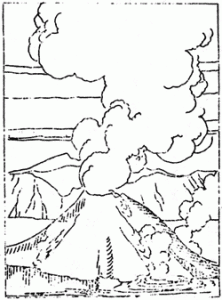In many cases a series of concentric bands, similar to the peelings of an onion, surround a central portion of rock that is relatively undecomposed. The cause of the banding is a common process observed in moist climates. Moisture penetrates the pore spaces of the rock. The depth of penetration depends upon the size of the pores, temperature, and character of the solutions. When the optimum depth has been reached, the moisture tends to decompose the rock. The new products formed are of greater volume than the original rock minerals. Consequently, swelling occurs and the shell of altered rock, as thick as the depth of moisture penetration, cracks away from the original rock. After the first shell has been released there is a ready passage for the succeeding influxes of moisture to penetrate the rock below and the same process repeats itself. This type of rock decay is called spheroidal weathering. Upon prolonged exposure to the elements the banding disappears and a homogeneous mass of soil is found where the boulder was situated originally. In a few instances the bands may appear to be of different colors. This is probably due to the amount of iron oxide absorbed by the soil during the breakdown of the boulders.
The foregoing examples can be readily contrasted with the fresh unaltered rocks along the talus slopes and the rock cuts along the trail. One is impressed by the ceaseless effort of natural forces to break down the rocks on the earth’s surface. This is to provide soil and plant food so that the fauna and flora of the earth may carry on their life functions.
The names of several rocks have been mentioned above. The first, pumice, is present in varying amounts along most of the trail. Its most common mode of occurrence here is as a fine buff-colored material. In a few places fragments several cubic inches sin volume may be found.
These larger fragments exhibit all of the common characteristics of pumice; namely, light buff-to-tan color, glassy texture, and high porosity.
Pumice is invariably associated with explosive vulcanism and consequently the original magma is charged with gases, usually water vapor and carbon dioxide. The gases, under pressure, are forced into the viscous lava, thus producing the characteristic porous texture. The lava hardens before the pore spaces are eliminated.v
The next most abundant rock is andesite. It differs markedly from pumice, both in composition and the manner of its formation. Andesite, the common flow rock of Crater Lake, is rich in iron, magnesium, and calcium, and poor in silica. Pumice, on the other hand, has a high silica content with very minor amounts of the other elements. The pressure of the iron, magnesium, and calcium in the lavas increases their fluidity, thus permitting them to flow over wide areas. Common with most andesites, those of Crater Lake are porphyries. That is, there are large crystals embedded in a more dense background called the ground mass. The most common cause for the formation of porphyries is a change in the rate of cooling. When deep within the earth, the lava started to solidify or crystallize and numerous minerals (feldspars) grew to the size shown in the rocks. Then pressure from below forced the lava to the cool surface where rapid solidification stopped the mineral growth and caused the running lava to harden about the earlier formed minerals.
The only other rocks of importance is a volcanic agglomerate. This is a rock composed of fragments of the various igneous (lava) rocks of the region. During periods of explosive action all of the types of rock present were thrown into the air and then upon descent filled cracks and gullies in the sides of Mt. Mazama. Later, lava flows or percolating waters caused the fragments to be more or less consolidated. Two-thirds of the way up the trail an excellent view station is located where one can observe masses of boulders caught in the lavas. This shows that in some parts of Mt. Mazama, lava flows and explosive eruptions were simultaneous. Perhaps the boulders merely tumbled down the mountain side and were caught in the flow, or else were engulfed as the lava moved along.
Fragments of the mineral quartz may be seen among the talus debris along the trail. The mineral is a variety known as milky quartz and is common the world over. It has formed by solutions rich in silica rising through cracks in the sides of Mt. Mazama. The rarity of quartz as well as other secondary minerals is significant.
In several places along the Garfield Peak Trail are large white blotches on the rocks. This is especially true of the areas of volcanic agglomerate. These white spots represent areas where hot moist gases escaped to the surface of Mt. Mazama.
The rocks are largely kaolinized, but with the outline of the rock fragments retained. If the rocks are rubbed with the fingers the typical clayey feel can be readily recognized.



